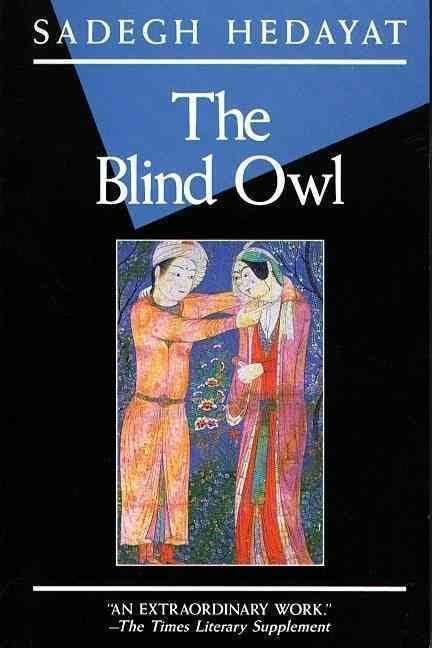8 /10 1 Votes
Original title بوف کور Published in English 1958 Originally published 1936 Genre Novel | 4/5 Goodreads Translator D. P. Costello Publication date 1936 ISBN 978-1-84749-069-8 Adaptations The Blind Owl (1987) | |||||||||||||||||||||||||||||||||
 | ||||||||||||||||||||||||||||||||||
Characters The Narrator's Mother, The Narrator, The Girl, The Narrator's Father, The Narrator's Uncle, The Narrator's Wife Similar Works by Sadegh Hedayat, Novels | ||||||||||||||||||||||||||||||||||
The blind owl sadegh hedayat 1974
The Blind Owl (1936) (Persian: بوف کور, Boof-e koor, listen ) is Sadegh Hedayat's magnum opus and a major literary work of 20th century Iran. Written in Persian, it tells the story of an unnamed pen case painter, the narrator, who sees in his macabre, feverish nightmares that "the presence of death annihilates all that is imaginary. We are the offspring of death and death delivers us from the tantalizing, fraudulent attractions of life; it is death that beckons us from the depths of life. If at times we come to a halt, we do so to hear the call of death... Throughout our lives, the finger of death points at us." The narrator addresses his murderous confessions to the shadow on his wall resembling an owl. His confessions do not follow a linear progression of events and often repeat and layer themselves thematically, thus lending to the open-ended nature of interpretation of the story.
Contents
- The blind owl sadegh hedayat 1974
- The blind owl extract p 82 83 sadegh hedayat english narration
- Translations
- Film
- References
The Blind Owl was written during the oppressive latter years of Reza Shah's rule (1925—1941). It was originally published in a limited edition in Bombay, during Hedayat's year-long stay there in 1937, stamped with "Not for sale or publication in Iran." It first appeared in Tehran in 1941 (as a serial in the daily Iran), after Reza Shah's abdication, and had an immediate and forceful effect. It is believed that much of the novel had already been completed by 1930 while Hedayat was still a student in Paris.
The blind owl extract p 82 83 sadegh hedayat english narration
Translations
The Blind Owl was translated into French by Roger Lescot during World War II, apparently with Hedayat's knowledge and approval, and published as La Chouette Aveugle (1953), and later by Pasteur Vallery Radot, a member of the French Academy. The book was well received in the French literary circles. It has been known to make its readers suicidal, hence the banning in Iran.
In Germany, two translations appeared in the early 1960s. The first, entitled Die Blinde Eule, was translated by Heshmat Moayyed, Otto H. Hegel and Ulrich Riemerschmidt directly from the Persian; the second, in East Germany, was translated by Gerd Henniger from the French version.
In Turkey, The Blind Owl was translated from Persian to Turkish in 1977 by the very famous Turkish poet Behçet Necatigil, under the title "Kör Baykuş".
The Blind Owl was translated into English by D.P. Costello (1957), by Henry D. G. Law, by Naveed Noori and by Iraj Bashiri (1974). Bashiri's translation was revised in 1984 and again in 2013.
In Poland The Blind Owl was translated from the Persian original by late specialist in Iranian studies, Barbara Majewska, Ph.D. It appeared under the same-meaning title "Ślepa sowa" twice. First in the respectable literary quarterly „Literatura na Świecie” (No 10(90), Warszawa, October 1978, pp. 4–116); then as a separate book (Warszawa, 1979).
In Romania, The Blind Owl was translated from Persian into Romanian in 1996 by the orientalist philologist Gheorghe Iorga, under the title Bufniţa oarbă. A revised second edition came out in 2006.
In Mexico, The Blind Owl was translated from the Roger Lescot's French version into Spanish by Agustí Bartra, under the title La lechuza ciega. It was published by Joaquín Mortiz Books in 1966.
In Urdu the novel has been translated by Ajmal Kamal with the original name Boof-e-Kor. Many of Hedayat's short stories have also been translated into Urdu, mostly by Bazl-e-Haq Mahmood, who published one volume of his short stories as Sag-e-Awara (Sag-e Velgard).
In India, two translations appeared in the Malayalam language. The first, entitled Kurudan Moonga, was translated by the famous novelist late Vilasini. The second, entitled Kurudan Kooman was translated by S. A. [Qudsi] and published by Mathrubhumi Books in 2005; second edition has been published by DC Books in 2011.
In Finland, The Blind Owl was translated from Persian into Finnish in 1990 by Henri Broms, Petri Pohjanlehto and Leena Talvio, under the title Sokea pöllö.
In Armenian, translated by Eduard Hakhverdyan.
In Japan, The Blind Owl was translated by Kiminori Nakamura and published by Hakusuisha in 1983 under the title "盲目の梟 (Mōmoku no Fukurou)."
In Indonesia, The Blind Owl was translated by Noor Aida a.k.a. Aida Vyasa and published by Dastan Books in 2004.
In Philippines, The Blind Owl was translated by Mercedes DL. Tulaylay under the title Bulag na Kuwago
Film
The novel was made into a film in 1974 (Boof-e-koor AKA The Blind Owl - available on YouTube), directed by Kiumars Derambakhsh, starring Parviz Fanizadeh, Farshid Farshood and Parvin Solaymani.
It was also made into the 1987 film The Blind Owl directed by Raúl Ruiz.
